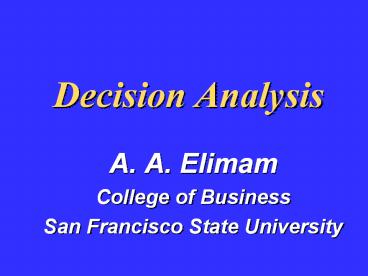Decision Analysis - PowerPoint PPT Presentation
1 / 23
Title:
Decision Analysis
Description:
Identify possible outcomes. Determine payoff for each alternative/outcome ... Decision Trees. Decision Table: Only Columns-Rows. Columns: State of Nature ... – PowerPoint PPT presentation
Number of Views:65
Avg rating:3.0/5.0
Title: Decision Analysis
1
Decision Analysis
- A. A. Elimam
- College of Business
- San Francisco State University
2
Characteristics of a Good Decision
- Based on Logic
- Considers all Possible Alternatives
- Uses all Available Data
- Applies Quantitative Approach
Decision Analysis Frequently results in a
favorable outcome
3
Decision Analysis (DA) Steps
- Clearly define the problem
- List all possible alternatives
- Identify possible outcomes
- Determine payoff for each alternative/outcome
- Select one of the DA models
- Apply model to make decision
4
Types of Decision Making (DM)
- DM under Certainty Select the alternative with
the Maximum payoff - DM under Uncertainty Know nothing about
probability - DM under Risk Only know the probability of
occurrence of each outcome
5
Decision Table Example
State of Nature (Market)
Favorable()
Unfavorable()
Alternatives
-180,000
200,000
Large Plant
-20,000
100,000
Small Plant
Do Nothing
0
0
6
Decision Making Under Risk
- Expected Monetary Value (EMV)
- EMV (Alternative i)
- (Payoff of first State of Nature-SN) x (Prob.
of first SN) (Payoff of second SN) x (Prob. of
Second SN) (Payoff of third State of
Nature-SN) x (Prob. of third SN) . . .
(Payoff of last SN) x (Prob. of last SN)
7
Thompson Lumber Example
- EMV(Large F.)
- (0.50)(200,000)(0.5)(-180,000) 10,000
- EMV(Small F.)
- (0.50)(100,000)(0.5)(-20,000) 40,000
- EMV(Do Nothing)
- (0.50)(0)(0.5)(0) 0
8
Thompson Lumber
State of Nature (Market)
Alternatives
Favorable ()
Unfavorable ()
EMV ()
200,000
Large Plant
-180,000
10,000
100,000
-20,000
Small Plant
40,000
0
0
Do Nothing
Probabilities
0.5
0.5
9
Expected Value of Perfect Information (EVPI)
- Expected Value with Perfect Information
- (Best Outcome for first SN) x (Prob. of first
SN) (Best Outcome for second SN) x (Prob. of
Second SN) - . . . (Best Outcome for last SN) x (Prob. of
last SN)
10
Expected Value of Perfect Information (EVPI)
- EVPI Expected Outcome with Perfect Information
- Expected Outcome without Perfect Information - EVPI Expected Value with Perfect Information -
Maximum EMV
11
Thompson LumberExpected Value of Perfect
Information
- Best Outcome For Each SN
- Favorable Large plant, Payoff 200,000
- Unfavorable Do Nothing, Payoff 0
- So Expected Value with Perfect Info.
- (0.50)(200,000)(0.5)(0) 100,000
- The Max. EMV 40,000
- EVPI 100,000 - 40,000 60,000
12
Decision Table Example
Possible Future Demand
Low ()
High ()
Alternative
270
200
Small Facility
800
160
Large Facility
Do Nothing
0
0
13
Example A.5
Demand
Alternatives
Low ()
High ()
EMV ()
270
200
Small
242
160
800
Large
544
0
0
Do Nothing
Probabilities
0.4
0.6
14
Example A.8Expected Value of Perfect Information
- Best Outcome For Each SN
- High Demand Large , Payoff 800
- Low Demand Small , Payoff 200
- So Expected Value with Perfect Info.
- (0.60)(800)(0.4)(200) 560
- The Max. EMV 544
- EVPI 560 - 544 16
15
Opportunity Loss Thompson Lumber
State of Nature (Market)
Favorable ()
Unfavorable()
0-(-180,000)
200,000-200,000
0-(-20,000)
200,000-100,000
200,000-0
0 - 0
16
Opportunity Loss Thompson Lumber
State of Nature (Market)
Alternatives
Favorable ()
Unfavorable ()
EOL ()
0
Large Plant
180,000
90,000
100,000
20,000
Small Plant
60,000
200,000
0
Do Nothing
100,000
Probabilities
0.5
0.5
17
Sensitivity Analysis
EMV,
Point 2, p0.62
EMV(LF)
Point 1 p0.167
200,000
EMV(SF)
100,000
EMV(DN)
0
1
-100,000
Values of P
-200,000
18
One Time Decision
19
Decision Trees
- Decision Table Only Columns-Rows
- Columns State of Nature
- Rows Alternatives- 1 Decision ONLY
- For more than one Decision Trees
- Decision Trees can handle a sequence of one or
more decision(s)
20
Decision Trees
- Two Types of Nodes
- Selection Among Alternatives
- State of Nature
- Branches of the Decision Tree
21
Decision Tree Example
Favorable (0.5)
Large
Unfavorable (0.5)
F. (0.5)
Small
U. (0.5)
Do Nothing
F. (0.5)
U. (0.5)
22
A Decision Tree for Capacity Expansion(Payoff in
thousands of dollars)
Low demand 0.40
70
Dont expand
90
Small expansion
High demand 0.60
(109)
2
Expand
(135)
1
135
Low demand 0.40
Large expansion
40
(148)
High demand 0.60
(148)
220
23
Decision Tree for Retailer
Low demand 0.4
200
High demand 0.6
Dont expand
Small facility
(242)
223
2
Expand
270
(270)
1
Do nothing
40
Modest response 0.3
3
(544)
20
Advertise
Low demand 0.4
Large facility
(160)
Sizable response 0.7
(160)
220
High demand 0.6
(544)
800































